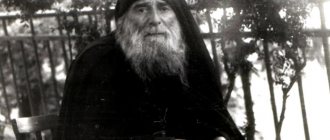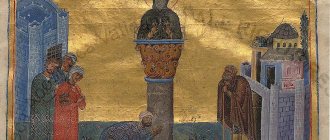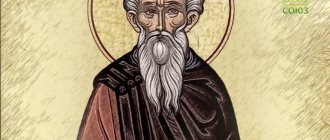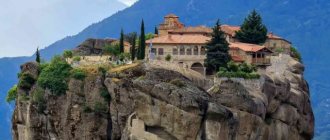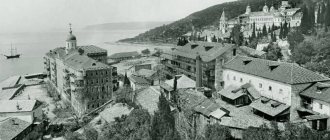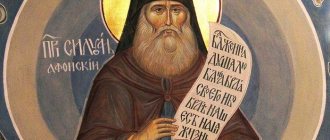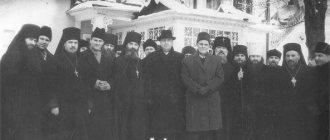People tend to complain about the times in which they live. It is common to sometimes embellish or, on the contrary, exaggerate the horrors of bygone times. Therefore, it is important to know and remember those who, regardless of the century allotted to him, cared no more about wealth, fame, career and other earthly goods.
About people who cared about the Word of God. Archimandrite Antonin Kapustin is such an example. This is a person whose name is associated with the formation and development of the Russian spiritual mission in Jerusalem.
Archimandrite Antonin Kapustin
Archimandrite - in the Russian Orthodox Church one of the highest monastic ranks, often the abbot of a large monastery.
The future archimandrite was born into a large family and was taught in the faith from childhood
The biography of Antonin Kapustin (in the world Andrei Ivanovich Kapustin) is instructive. A boy from a remote Siberian village, from a family with thirteen children, most of whom died at an early age, became a representative of the Russian Orthodox Church in Palestine.
Born on August 12, 1817 in the village of Baturino, Shadrinsky district, Perm province (now Shadrinsky district, Kurgan region), in the family of the hereditary priest Ivan Leontyevich Kapustin and Maria Grigorievna Varlakova.
November 7, 1845
Andrey Kapustin became a monk with the name Antonin
He studied at the Dolmatov Theological School, at the Perm and Ekaterinoslav Theological Seminaries. Then in 1839-1843. at the Kyiv Theological Academy. After graduation, he taught there.
On November 7, 1845, Andrei Ivanovich Kapustin became a monk with the name Antonin. On May 15, 1850, Father Antonin was appointed rector of the church at the Russian embassy in Athens. His work in restoring this church was noted by the Holy Synod, and in 1853 Antonin Kapustin was elevated to the rank of archimandrite. During these years, he collected and studied more than 200 Christian inscriptions from Athens from the 6th to 12th centuries.
In 1860-1865, Archimandrite Antonin was rector of the embassy church in Constantinople. From 1865 until the end of his life he was the head of the Russian Spiritual Mission in Palestine.
In the Assumption Dalmatovsky Monastery, on the 200th anniversary of the birth of the outstanding head of the Russian spiritual mission in Jerusalem, a native of the Trans-Urals, Archimandrite Antonin (Kapustin), and in 2021, on the 200th anniversary of the Dalmatovsky Theological School, of which Fr. Antonin, the exposition of the monastery museum is open. The interior of the room is made in the Middle Eastern style. Each showcase contains exhibits illustrating the main stages of life, places associated with activities, activities and hobbies of Fr. Antonina. All exhibits are original items from the 19th century - early 19th century. XX centuries: printed publications, photographs, documents, letters, postcards, lithographs, coins, banknotes, stamps, insignia, household items, pilgrimage relics.
The Museum of the Dormition Dalmatovo Monastery, opened in 2012, in 2015 with the blessing of His Eminence Vladimir, Bishop of Shadrinsky and Dalmatovsky, was named after a graduate of the Dalmatovo Theological School, a native of the Trans-Urals, the famous head of the Russian spiritual mission in Jerusalem, Archimandrite Antonin (Kapustin).
On May 13, 2021, within the framework of the scientific conference “From Trans-Urals to Jerusalem: the personality, works and era of Archimandrite Antonin (Kapustin)” held in the Dalmatovsky Monastery, dedicated to the upcoming 200th anniversary of the birth of the outstanding church figure and scientist in 2021 and the celebrated in 2021, the 200th anniversary of the opening of the Dalmatovo Theological School, of which Fr. Antonin, the grand opening of a memorial plaque on the building of the northern cells and an exposition of the monastery museum dedicated to the life and work of Archimandrite Antonin took place.
The monastery museum currently includes three exhibitions, one of which is dedicated specifically to Fr. Antonin. This exhibition is not only intended to acquaint visitors and pilgrims of the monastery with the life and works of our famous fellow countryman, who spent five youthful years (from 1825 to 1830) within the walls of the Dalmatovsky Monastery, that is, to reveal one of the pages of the history of the monastery, but also to become in some way "memorial" about. Antonin in his small homeland. Why a memorial - because the creation of museums, as you know, is one of Fr.’s favorite things. Antonina. In this sense, the very fact of creating a museum in the Dalmatovsky Monastery is a tribute to the memory of our famous fellow countryman.
There are several basic principles for the formation of a museum exhibition.
- For obvious reasons, the museum does not contain personal belongings of Fr. Antonina. Therefore, we set ourselves the task of imagining: the era to which Fr. Antonin; institutions (educational, church, scientific, diplomatic, pilgrimage) to which he was related; countries and localities in which he lived or which he visited on his trips; lifetime editions of his works; pilgrimage relics from the Holy Land and Mount Athos; objects that characterize his hobbies (astronomy, photography, tea drinking), etc.
- Almost exclusively original items (i.e., not copies) were selected for display, with rare exceptions (such exceptions are, for example, copies of the Russian Orders of St. Anna, 1st class, and St. Vladimir, 2nd class, awards granted to Father Antonin, the originals of which are worth fabulous money).
- We tried to present exhibits that were as diverse in type as possible. These are: photographs and stereo photographs, lithographs, postcards, letters and postcards, geographical maps and plans, printed publications (books, magazines, brochures, albums), documents, church utensils (altar crosses, prayer crosses and body crosses, icons, icons and other pilgrimage items). relics), awards and insignia, coins, banknotes, stamps, household items and scientific instruments.
- Most of the exhibits were purchased via the Internet from private individuals, although there are some welcome exceptions. For example, a resident of Yekaterinburg, Anna Aleksandrovna Lebedeva, donated personal belongings to the museum (a cypress chest, a clay jug and a photograph of Russian pilgrims immersing themselves in the waters of the Jordan), which she inherited from her grandmother’s sister Ksenia Dmitrievna Chudinova (1865-1943), who was born near the Dalmatovsky Monastery and who made a pilgrimage to the Holy Land before the revolution and even lived there for several years. Shadrinsky photographer Andrey Nikolaevich Khitailenko, a native of the village. Baturino (that is, a fellow countryman of Father Antonin), donated to the museum copper crosses and icons found in the Baturino land, which could well have been consecrated by someone from the Kapustin priestly family. Chelyabinsk antiquarian Nikolai Vladimirovich Kozlov donated to the museum a pocket-sized New Testament in Greek from 1873, an edition with a dedicatory inscription from the famous mathematician, specialist in the field of number theory, Shadrinsk priest Ivan Mikheevich Pervushin (1821-1900), as well as a wooden cross with oil painting, having some kind of pilgrimage relic on the side as an insert. At the Alexander Metochion in Jerusalem, Nikolai Alexandrovich Vorontsov presented the 1955 Paris edition of Archimandrite Cyprian’s (Kern) pamphlet “In Memory of Archimandrite Antonin (Kapustin).”
- Unfortunately, the history of most of the exhibits remains unknown to us. But there are exceptions here too. In particular, there are three objects (a seven-tree wooden altar cross with oil painting, a pectoral carved (with vine ornament) mother-of-pearl cross and a small icon of the Resurrection of Christ, printed on silk), about which we know that they belonged to a Samara merchant from of an impoverished St. Petersburg noble family to the honorary citizen of Samara Pyotr Nikolaevich Arefiev. P.N. Before the revolution of 1917, Arefiev was the owner of a store and warehouse of photographic supplies, chairman of the Samara Photographic Society, and was also allegedly engaged in the sale of electrical products. Using his own funds, he made a project for lighting the Samara Cathedral and provided the temple with lighting fixtures. He traveled a lot, including a visit to Jerusalem, from where he probably brought the things that ended up in our museum. He knew many famous people of that time, helped the revolutionaries and suffered from this himself. Pilgrimage relics were kept by the descendants of P.N. Arefiev and were purchased from them for the monastery museum. A cypress chest purchased for the museum with an inscription on the lid in French “RUSSIAN IMPERIAL CONSULATE” (Russian Imperial Consulate), according to the testimony of the former owner of this thing, was brought to our country from the Russian Imperial Consulate in Jerusalem at the beginning of the 20th century. and until a certain time it was kept as a family heirloom. The belt buckle of a soldier of the army of the Ottoman Empire, according to the testimony of the former owner of the item, was found at the Shipka Pass, a famous site of fighting in the Russian-Turkish War of 1877-1878.
- The monastery has limited availability of free premises, so we needed to place a fairly large number of exhibits (more than 600 items) in a small space (30 sq.m.). This explains the high density and richness of exhibits in display cases, where literally every centimeter is used, and minimal explanatory information for each exhibit.
- Our goal was to give an overview of all stages of Fr. Antonina, starting from childhood in Baturino and the Dalmatovsky Monastery and ending with the Holy Land. In total, the exhibition includes 13 display cases, 1 glazed niche in the wall and 23 wall tablets.
Brief overview of the museum exhibition. The monastery museum itself is located in the building of the northern cells of the Dalmatovo monastery (built in the early 19th century). The exhibition dedicated to Archimandrite Antonin occupies one room on the ground floor with a separate entrance. The interior of the room was created taking into account the Middle Eastern flavor: the floors are lined with golden-yellowish flagstone (similar to the streets of Jerusalem), light stone inserts were also used for wall decoration; There is a decorative column in the middle of the room. The room is located below the surface level of the monastery territory, so to enter you need to go down the flagstone steps a little down.
At the entrance to the hall on the left (west) side there is a niche in the wall, presumably intended for storing books. It is in this capacity that it is used in our museum exhibition. Old printed books are placed on three shelves behind glass. Two tablets contain information about the history of the monastery library, the first mention of which dates back to 1679, i.e. the time of the founder of the monastery, St. Dalmat of Isetsky, as well as the history of religious educational institutions located from the beginning of the 18th century. (1714) and until the beginning of the twentieth century. in the Dalmatovsky Monastery.
Next to the niche on the western wall there is a tablet with a short biography of Fr. Antonin and his photographs. Large photo of Fr. Antonina in a frame is also placed in the center of the opposite (eastern) wall in a niche lined with stone tiles and topped with a relief sign of the IOPS.
In the western wall of the room there is an arch for the entrance to the adjacent room, where it is planned to place another museum exhibition. On the other side of the arch there are two floor display cases.
The first contains exhibits illustrating the beginning of Andrei Kapustin’s life and his years of study. Here are presented: an icon and a short life of St. martyr Andrei Stratelates - the heavenly patron of Andrei Kapustin, found in the land of the village. Baturino pectoral crosses and icons, photographs of residents of the Shadrinsky district con. XIX–early XX centuries with seals of Shadrin photographers, buttons, cockade, belt badges for students of theological schools and seminaries, educational literature of the 19th century, a postcard with a view of the Perm Theological Seminary and a lithograph with a view of the Kiev-Brotherly Monastery, where the Kiev Theological Academy was located, a diploma from the beginning. XX century on graduation from the Kyiv Theological Academy, priestly service book published in 1864, New Testament in pocket format in Greek published in 1873.
In the tablets on the wall above the display case there are lithographs of the beginning. XX century with views of the Dormition Dalmatovo Monastery and the Kiev Pechersk Lavra, as well as postcards with views of Perm, Ekaterinoslav and Kyiv, i.e. cities where the teaching of the future Fr. Antonina.
In the second floor display case there are exhibits characterizing the period of Archimandrite Antoninus’ service in Athens (1850-1859) and trips to Egypt (1857) and Sinai (1870): copies of color lithographs by Con. XIX century with views of the restored island. Antonin of the Trinity Church of St. Nicodemus in Athens, books and brochures early. XX century about Greece and archaeological excavations, works of Greek photographers con. XIX - early XX centuries, New Testament in Greek, 19th century edition, letter in Greek 1875, Greek promissory note beginning. 20th century, Greek coins from the reign of King Otto I (1832-1862), i.e. when o. Antoninus lived in Athens, ancient Greek, ancient Roman, Jewish and Byzantine coins; coins of Ottoman Egypt, ser. XIX–beg. XX centuries, i.e. time when Fr. Antonin was in this country, color pilgrimage postcards early. XX century with views of Mount Sinai and the monastery of St. VMC. Catherine, books by A.S. Norov “Travel through Nubia and Egypt” (1854) and “Description of Greek manuscripts of the monastery of St. Catherine in Sinai. T. I" (1911).
On the tablets on the wall above the display case are maps and postcards with views of Athens, Cairo, and Alexandria.
In the corner display case, under a glass cover, are exhibits illustrating the habit of Fr. Antonina – tea party: Russian samovar beginning. XX century, jars, boxes, labels and advertising cards of Russian tea companies. XIX - early XX centuries
Along the northern wall there are three floor display cases. The first of them contains exhibits illustrating the Constantinople period of Fr. Antonina (1860-1865): coins of the Ottoman Empire. XVIII–beg. XX centuries, a letter from Taganrog to Constantinople in 1867 and a postcard from Alexandria to Constantinople early. XX century, stamps of the Ottoman Empire. XIX–beg. XX centuries, copies of lithographs of the 19th century. with a portrait of Sultan Abdulmecid I (1839-1861) and a view of the house of the Russian Imperial Embassy in Constantinople, photograph and color postcards of the beginning. XX century with the image of the Turks, the book “Laws of the Ottoman Empire” in Greek 1889, the book in Arabic con. XIX - early XX centuries, photo album “Views of Constantinople”, early. 20th century, badge of the Ottoman Order of Medzhidiye IV degree, medals of the Ottoman Empire Imtiyaz and Liaqat with original blocks, cockade, button and belt buckle of soldiers of the Ottoman Empire, cigarette case with the coat of arms of the Ottoman Empire.
In the tablets above the display case there is a map, individual views and a panorama of Constantinople from color postcards from the beginning. 20th century, drawing of a mosque with an Arabic inscription, presumably early. XX century, banknotes of the Ottoman Empire, mid. XIX century, documents on ownership of real estate (deeds of sale) of the Ottoman Empire, early. XX century
The next showcase contains exhibits related to Mount Athos, which Fr. Antonin visited twice (1859, 1863): a set of postcards with views of the monasteries and hermitages of Mount Athos. XIX - early XX centuries, “Illustrated guide to the holy places of the East. Part I. From Odessa to Athos, Part II. On Athos" 1903, brochure "Pilgrim, or necessary guidance for persons visiting St. Mount Athos" with a map of the Holy Mountain of 1890, icons (lithographs on wood) of small size and paper postcards-lithographs with seals-blessings of Russian Athonite monasteries on the back, envelopes of letters to the Athonite monasteries, receipt forms, sheets for pilgrims, pilgrimage postcard with a view of the Holy Mountain, color postcard with the image of the Patriarch of Constantinople Joachim III early. 20th century, Greek copper body icon. XIX - early XX centuries
In the next showcase there are samples of Russian printed publications of the con. XIX–beg. XX centuries about the Holy Land: an annual selection (12 issues) of the free supplement “Palestine” to the magazine “Russian Pilgrim” for 1916, “Palestine leaflets” of the IOPS beginning. 20th century, albums with views and drawings, guides and signs to the Holy Land, descriptions of travels to the Holy Land by A.S. Norova, D.L. Mordovtsev, conversations, words, poems and edifying instructions to pilgrims, services and akathists to saints with the blessings of the abbots of the monasteries.
On the wall above the display cases in tablets are colored postcards from the beginning. XX century with views of Rome and Rumelia, i.e. places visited by Fr. Antonin on his travels.
In the second corner showcase, under a glass cover, objects that characterize Fr.’s hobby are presented. Antonina astronomy: German cabinet telescope of the 19th century, astrolabe presumably late 19th – early. XX centuries, book on astronomy in Arabic, 1904.
There are four floor display cases along the east wall. The first contains exhibits related to the activities of various institutions of the Russian Empire in the Holy Land (RDM, IOPS, ROPiT, Russian Imperial Consulate in Jerusalem): leaflets published by the IOPS in the beginning. XX century, envelope letter from Korsun to RDM 1885, bank check form indicating the current account of the IOPS beginning. XX century, books “Report of the Orthodox Palestine Society for 1882-1883” and “Orthodox Palestinian collection. 49th issue" 1898, postcard lithographic portrait of the head of the RPM Archimandrite Raphael 1894, documents on the letterhead of the Russian Imperial Consulate in Jerusalem 1885 and ROPiT 1912, foreign passport of a Russian pilgrim with seals, incl. and consulates in Jerusalem in 1869, tabletop anniversary medal “50 years of ROPiT (1857-1907)”, uniform buttons of ROPiT employees, stamps and postcards issued by ROPiT, faience soup plate with the monogram of ROPiT con. XIX–beg. XX centuries
The second showcase contains pilgrimage relics and correspondence to the Holy Land: herbariums “Flowers of the Holy Land” bound in olive wood. XIX century, paper icons (lithographs) from the Holy Land and an icon of the Resurrection of Christ with the blessing of the Holy Sepulcher printed on silk late 19th – early. XX centuries, photography, lithographic portraits and letters of permission of the Jerusalem patriarchs Gerasim and Damian, envelopes, letters (including money) and postcards from Russia to the Holy Land, postcards with blessing seals and leaflets of various Palestinian monasteries.
The third showcase presents lifetime publications of Fr. Antonina, a lithograph of the icon he painted, “The Face of the Savior in the Crown of Thorns,” pasted on a board, late 19th century. with an inscription on the back of the owner-pilgrim 1903 and seals-blessings of St. city of Jerusalem, pilgrimage postcard and picturesque icon of the “Kissing of the Mother of God and Righteous Elizabeth” con. XIX - early 20th century, Parisian edition 1955 of the brochure of Archimandrite Cyprian (Kern) “In Memory of Archimandrite Antonin (Kapustin) (1817-1894)”, copies of Russian orders awarded to Fr. Antonin - star and cross of St. Anna I degree and St. Vladimir II degree, Greek Order of the Savior IV degree, part (central oval) of the sign of a member-employee of the IOPS con. XIX - early XX centuries, a priest's cross on a Vladimir ribbon and a light bronze medal on an St. Andrew's ribbon for the Crimean War.
In the last display case in this row, pilgrimage relics from the Holy Land are displayed - copies of the Gethsemane Shroud of the Mother of God with blessing seals on the back. XIX century
Above the display cases, tablets on the wall display stereo photographs and color pilgrimage postcards with views of the holy places of Palestine, “Jerusalem portraits” - the works of Jerusalem photographers of the early 19th century. 20th century, lithographs “View of the Temple and the Holy Sepulcher in Jerusalem”, “The ritual of distributing the Holy Fire on Holy Saturday in the Church of the Holy Sepulcher in Jerusalem” and the leaflet “Appeal of the IOPS on plate collection for the needs of the Orthodox in the Holy Land”, beginning. XX century
A large corner showcase displays other pilgrimage relics from the Holy Land: picturesque icons, with relief seals on metal, lithographs pasted onto boards with seals of blessings on the back, carved wood and cut olives, picturesque on marble, carved in stones, from shells on mother-of-pearl, “seven-tree” crosses, crosses made of mother-of-pearl, plaque.
The last showcase near the exit displays cypress chests: one with an inscription on the lid is from the Russian Imperial Consulate in Jerusalem, the other belonged to the Russian pilgrim K.D., who was born in the Trans-Urals. Chudinova, both brought at the beginning of the twentieth century. to Russia from Palestine, here are K.D.’s personal belongings. Chudinova - a photograph of Russian pilgrims immersing themselves in the Jordan and a clay jug, also brought from the Holy Land.
Above the display case on the southern wall are tablets of Greek color lithographs, geographical maps and postcards with views of the holy places of Palestine in the early 19th century. XX century
Father Antonin developed the Orthodox society in Palestine
It was in this field that Antonin Kapustin made a contribution to Russian Orthodoxy and the Orthodox Palestinian society in the Holy Land. For many, many years, Orthodox pilgrims from Russia have experienced incredible difficulties when visiting holy places, from arrival and accommodation to safety.
Father Antonin was engaged in the purchase of lands associated with the Old and New Testaments.
On these lands, temples and shelters were built where pilgrims could be received and accommodated. But before the construction of temples, archaeological excavations were carried out on these lands. Despite the damage caused to the Russian presence in Palestine by the policies of the Khrushchev era, these sites still serve Russian pilgrims today.
1895
from this year Father Antonin was the head of the Russian Spiritual Mission in Palestine
The acquisition of land in the nineteenth century on the territory of the Ataman Empire was prohibited.
Therefore, Father Antonin was forced to acquire these lands in the name of his translator, an Orthodox Arab, and then register them as his own, in turn drawing up a will on the transfer of these lands after his death to the Holy Synod.
Archaeological excavations were carried out in the lands he acquired, since they were not chosen at random and were associated with Old and New Testament references. Thanks to excavations in Russian sites, ancient city walls in Jerusalem were discovered, and the true threshold of the “Gate of Judgment” through which the Lord Jesus Christ left the city to Golgotha was discovered.
Later, the Alexander Metochion with the Church of St. Alexander Nevsky was built on this site.
Threshold of the Judgment Gate. This is an Orthodox shrine that was found thanks to the work of Antonin Kapustin
These discoveries became a sensation in Europe and Russia, as they confirmed many of the events of the New Testament, which by that time some people had begun to doubt.
Through the efforts of Father Antonin, the land around the Mamvrian Oak on the Mount of Olives was acquired, on which a monastery was later built, as well as the top of the Mount of Olives. Before the construction of the monastery, archaeological excavations were carried out, where ancient mosaics and burial caves were discovered.
Acquired plots
In 1869, with the assistance of Archimandrite Antonin, the Mamvrian oak was acquired, and a little later the nearby lands (about 72,355 m) were purchased. On June 12, 1869, the head of the mission celebrated the first Divine Liturgy at the site of the appearance of the Holy Trinity to Abraham. In 1870, the top of the Mount of Olives was acquired.
At the same time, the largest possession of the Russian Empire was acquired in the Holy Land in Ein Karem.
In the same years (1869), Kapustin acquired an estate near Jaffa on the way to Jerusalem - the burial place of Saint Tabitha, where the Church of the Apostle Peter was built. A farmstead for pilgrims' rest was also purchased in Tiberias.
In Beit Jala, Antonin bought two properties, on one of which a school for girls and a female teachers' seminary were founded.
In Gethsemane, he successfully acquired a place where, at the request of the royal family, the Church of St. Mary Magdalene, Equal-to-the-Apostles, was built.
In total, Archimandrite Antonin purchased and legally registered 13 plots, with an area of about 425,000 m, worth up to a million rubles in gold.
Antonin zavakufiled his real estate (that is, the property is not subject to sale, exchange or other transactions leading to their alienation until Antonin’s death, and then passes into the possession of the Synod; if the Synod ceases to exist, then these lands become the property of all Orthodox Russian people, and if and they disappear, then the lands come to the disposal of the Jerusalem Qadi.
The archimandrite was engaged in historical scientific activities in his trips to Orthodox places
In addition to expanding the possessions of the Russian Orthodox Church, in addition to extensive scientific work, Archimandrite Antonin Kapustin made numerous trips to Orthodox places, studying ancient manuscripts, early printed books, describing Orthodox books and rituals in his diaries and articles in various magazines.
Books by Antonin Kapustin on the website of the electronic publishing service "Litres"
Having made a trip to Athos, he described in great detail the architecture, wall paintings, characteristic features of Athos worship and the life of the monks.
He wrote a large number of books, scientific works and articles in religious magazines on theological topics. Among which stands out about, “Notes of a worshiper of the Holy Mountain”, “The Torment of St. Domnina", "Week of the Passion of Christ", "Pharaoh, Moses and the Exodus".
For services to the fatherland, Father Antonin was awarded the Imperial Order of St. Equal-to-the-Apostles Prince Vladimir, II degree, the Imperial Order of St. Anna, I degree, the Imperial Order of St. Equal-to-the-Apostles Prince Vladimir, III degree, and Commander of the Greek Order of the Savior.
The prophecies of Antonin Kapustin were lost
Archimandrite Antonin Kapustin died on March 24, 1894 in Jerusalem. The burial place of Father Antonin is the Ascension Cathedral on the Mount of Olives, built under his leadership. The prophecies of Antonin Kapustin are of particular interest.
In modern times, during the study of the cave of John the Baptist in Jerusalem, in which Father Antoninus lived for a long time, his archive with prophetic testimonies was discovered.
Inexplicably, the archive itself and all the nuns who read it disappeared.
There was only one witness left to this discovery - Mother Fotina. From her words, there was a recording in the archive:
“I, the sinful Archimandrite Antonin Kapustin, laid the foundation stone for the upper church of All Saints in Rus' who shone forth. But I had a vision: I won’t finish it, it will be completed before the coming of the Antichrist.”
The life and deeds of Archimandrite Kapustin are a good example for many generations of Russian Orthodox people. 2021 in the Kurgan region was declared the year of the 200th anniversary of Archimandrite Antonin Kapustin.
By leaving a comment, you accept the user agreement
